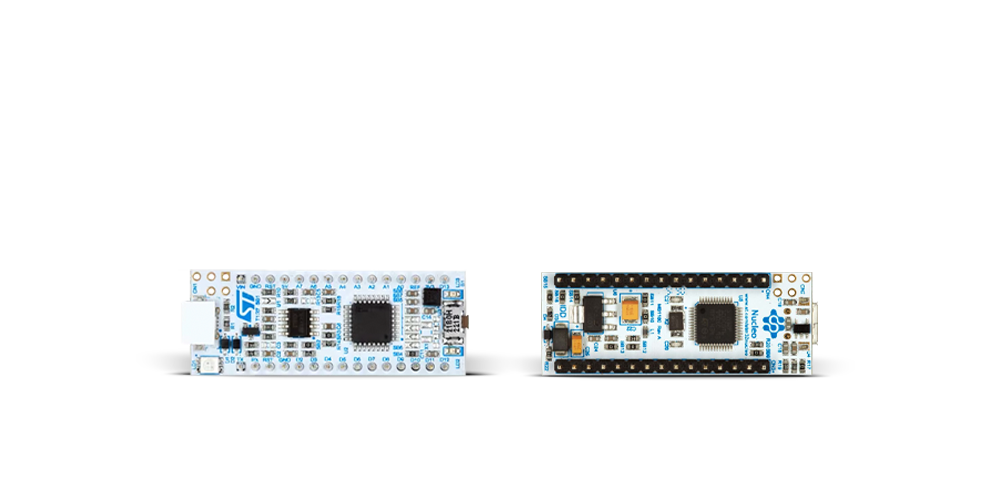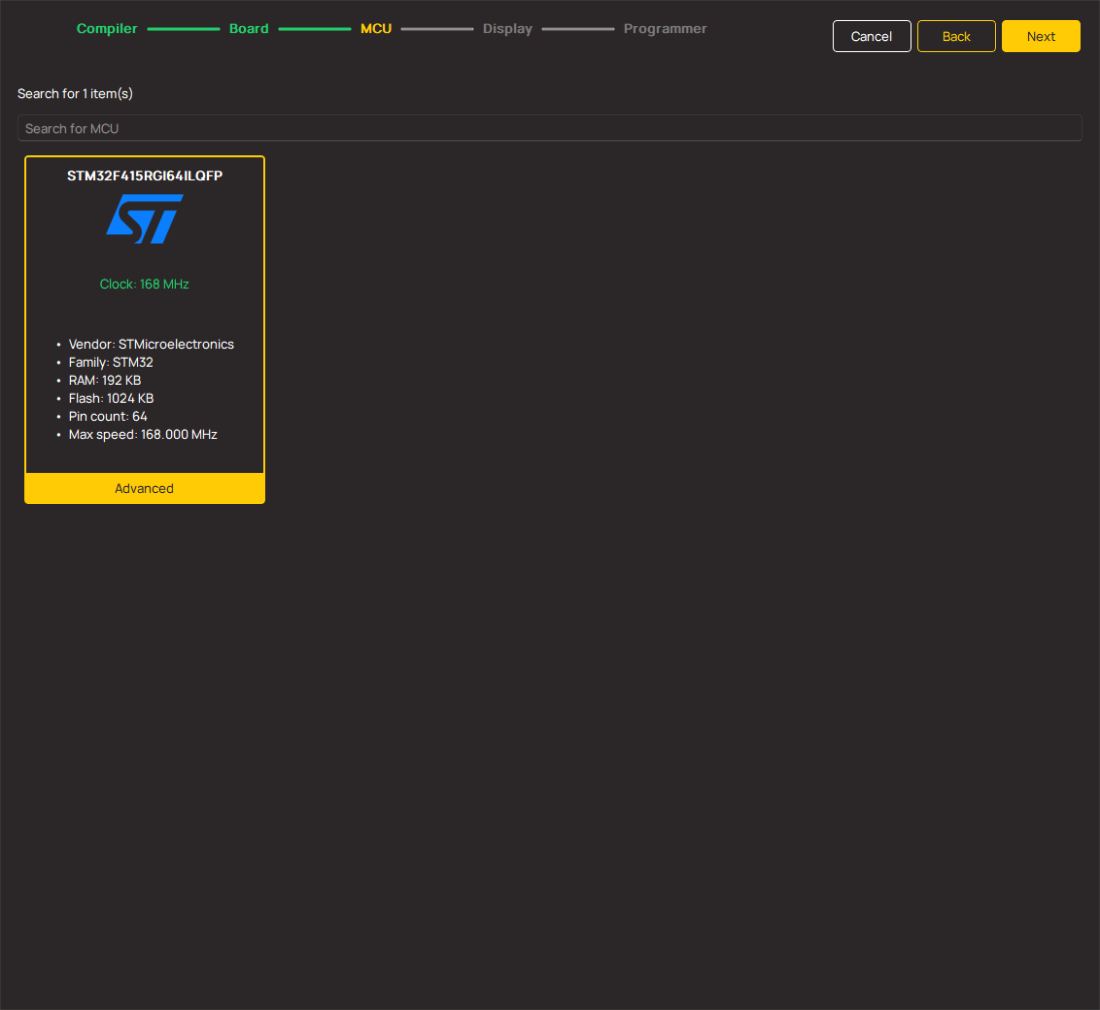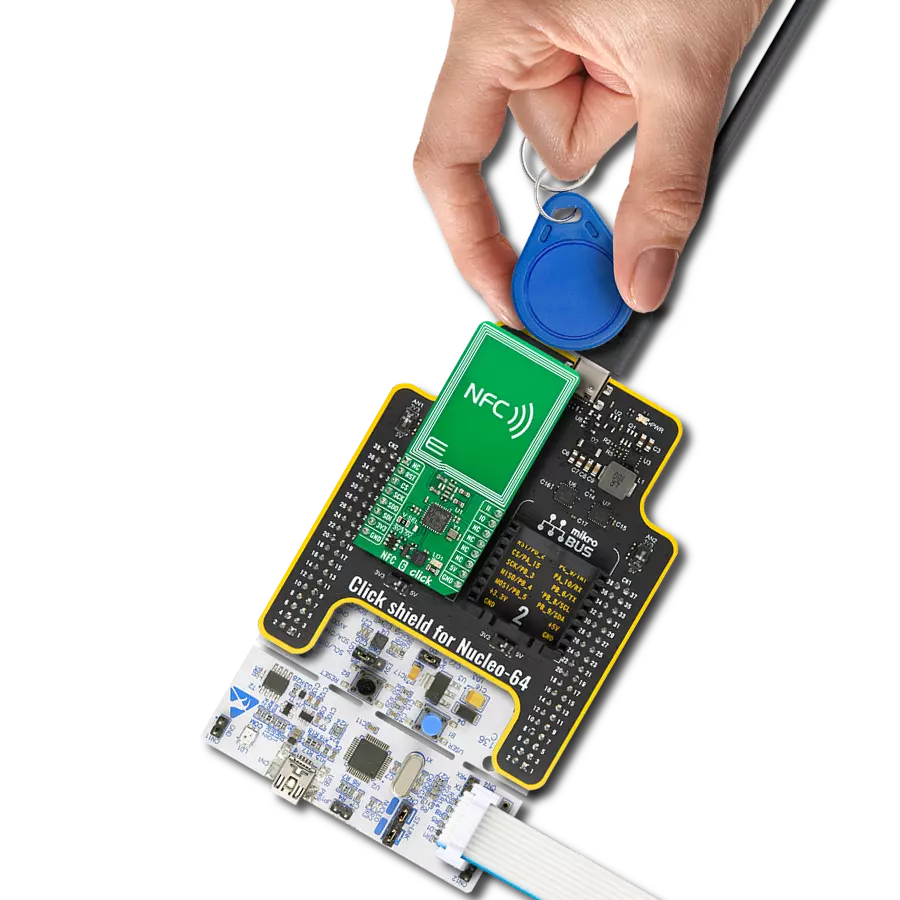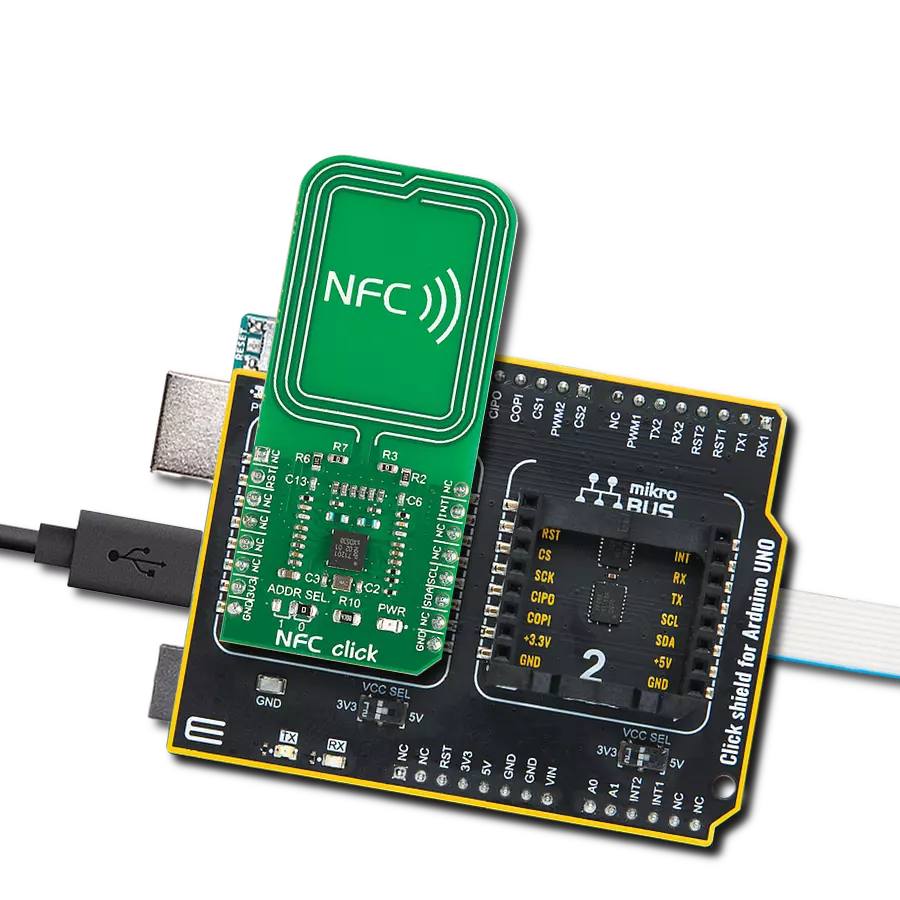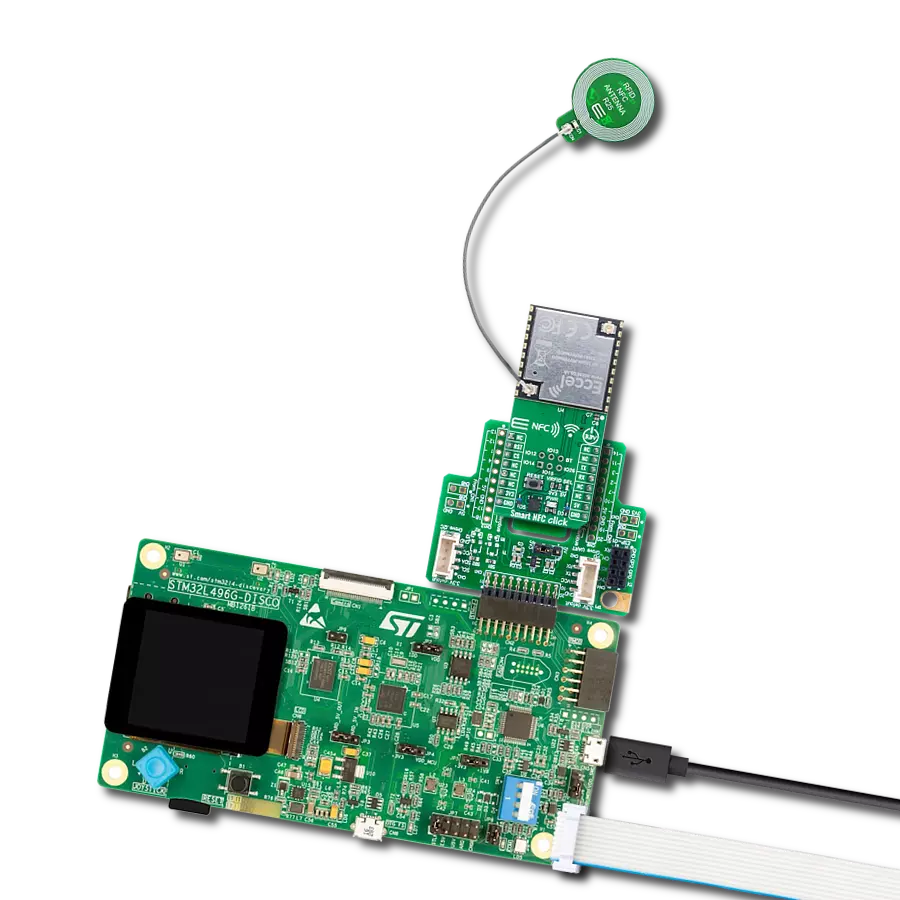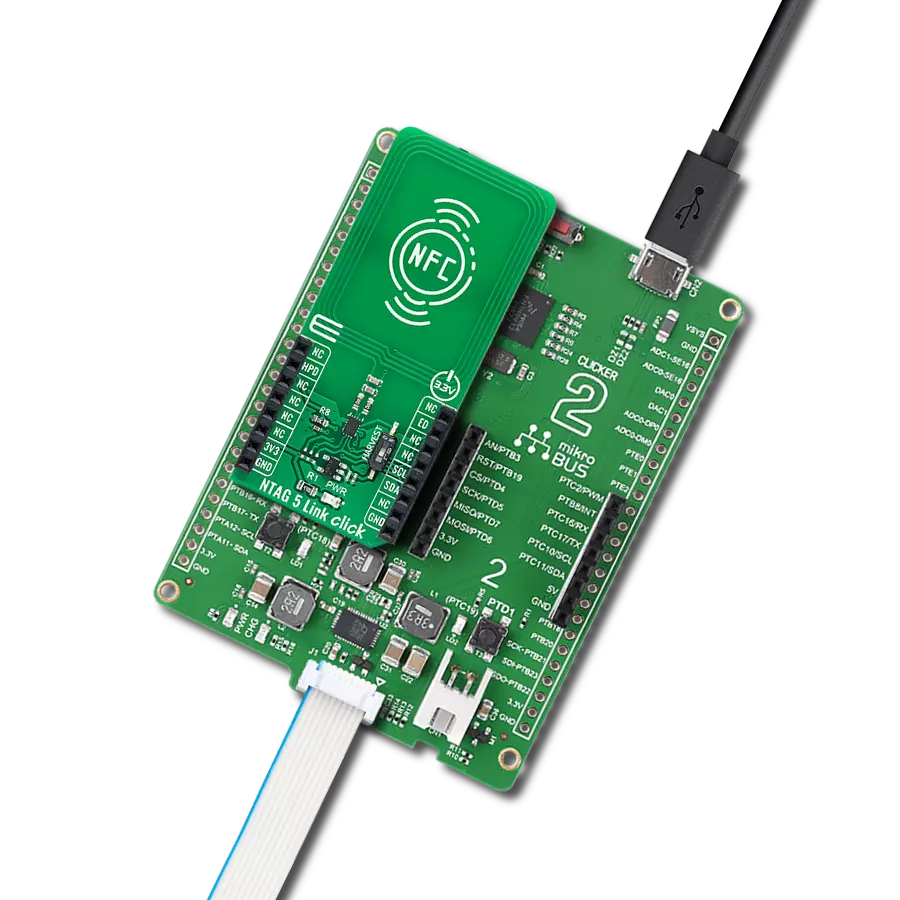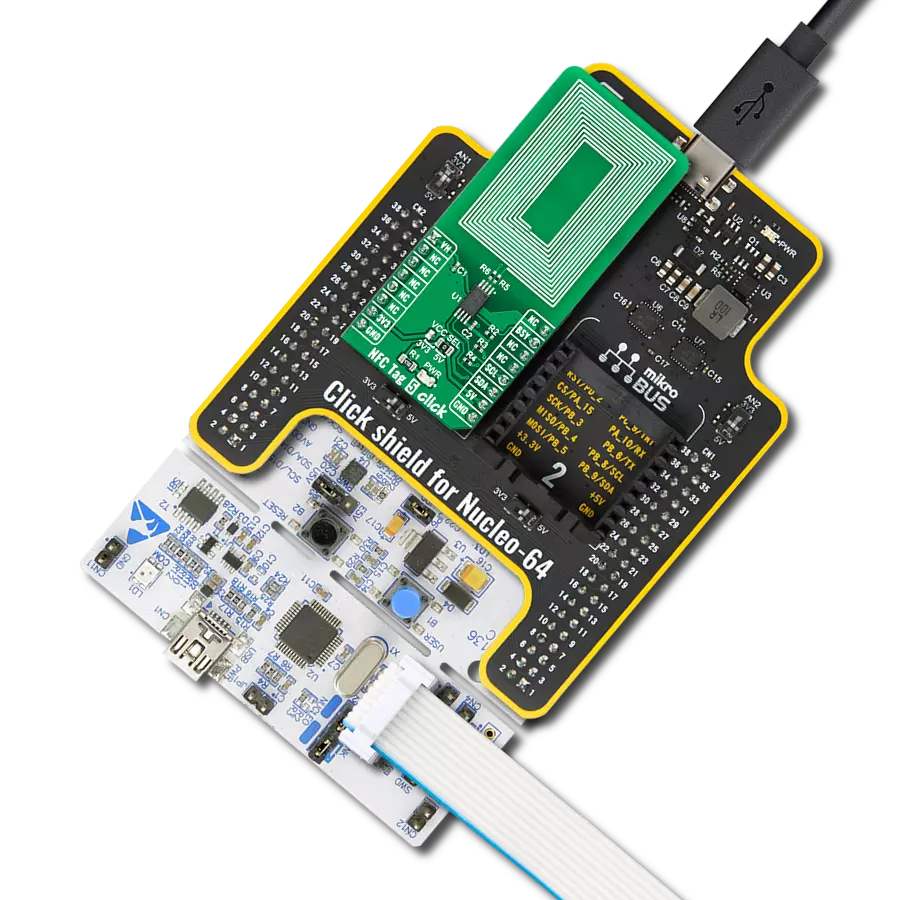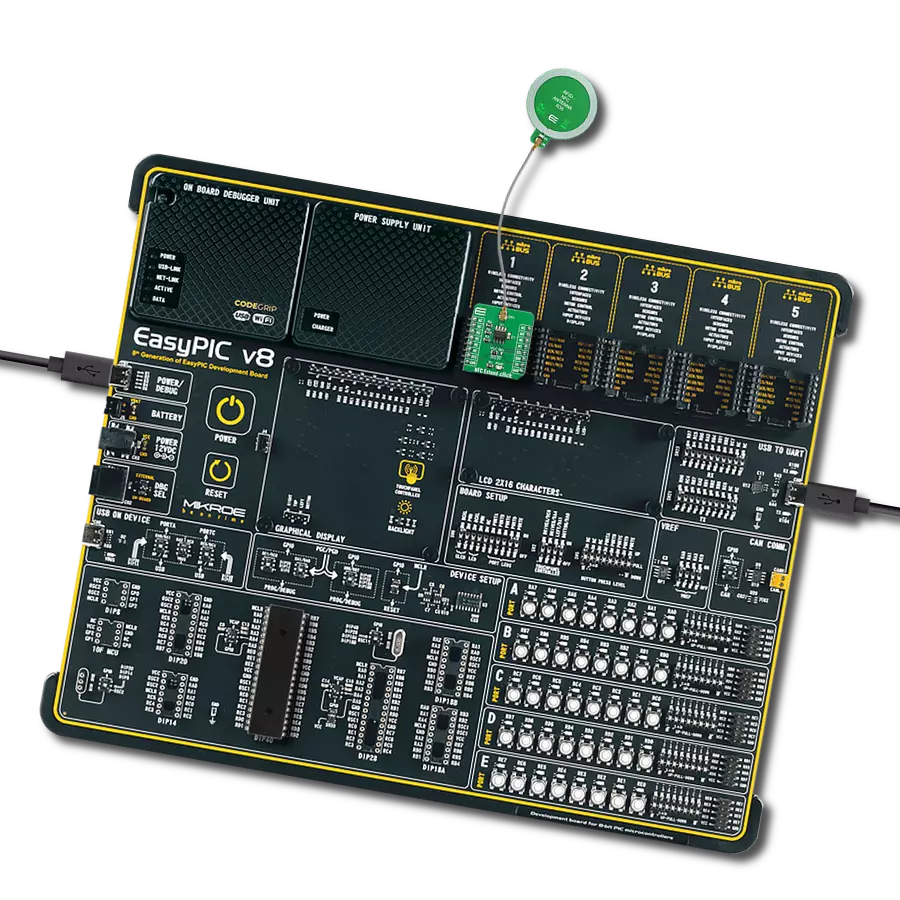Embrace the NFC experience and see how it extends from simple data sharing to device control, offering a more connected and efficient way of interacting with your digital world
A
A
Hardware Overview
How does it work?
NFC Tag 4 Click is based on the ST25DV16, a compact NFC tag IC from STMicroelectronics. The Click board™ itself has a reasonably small number of components because most of the interface and EEPROM memory circuitry is already integrated on the ST25DV16K IC. The I2C / SMBus compatible serial interface lines, along with the GPO pin, which also works in the open drain configuration, are pulled up by the onboard resistors. The 2-Wire lines are routed to the respective I2C lines of the mikroBUS™ (SCK and SDA), while the GPO pin of the main IC is routed to the INT pin of the mikroBUS™. The ST25DV16K uses the I2C/SMBus compatible communication interface, offering a fast transfer mode (FTM), to achieve a fast link between RF and contact worlds, via a 256 byte buffer called Mailbox. This mailbox dynamic buffer of 256 byte can be filled or emptied via either RF or I2C. There is also the INT pin available, which
indicates incoming event to the contact side, like RF Field changes, RF activity in progress, RF writing completion or Mailbox message availability. The built in energy harvesting element can deliver µW of power when external conditions make it possible. The integrated RF management allows the NFC Tag 4 click to ignore RF requests. All these features can be programmed by setting static and/or dynamic registers of the ST25DV16K. ST25DVxxx can be partially customized using configuration registers located in the E2 system area. More information about all the registers can be found in the ST25DV16K datasheet. However, provided library contains functions that simplify the use of the NFC Tag 4 click. The included application example demonstrates their functionality and it can be used as a reference for custom design. In order to make sure that no external components are required in order to use
it, this Click Board™ contains the integrated trace antenna on the PCB. The antenna coil is correctly tuned and can be used to power and access the device using the ISO/IEC 15693 and ISO 18000-3 mode 1 protocols. Power is transferred to the ST25DV16K by radio frequency at 13.56 MHz via coupling antennas of the NFC Tag 4 click and the NFC Reader being used. The ISO 15693 standard defines the carrier frequency (fC) of the operating field as 13.56 MHz ±7 kHz. This Click board™ can operate with either 3.3V or 5V logic voltage levels selected via the VCC SEL jumper. This way, both 3.3V and 5V capable MCUs can use the communication lines properly. Also, this Click board™ comes equipped with a library containing easy-to-use functions and an example code that can be used as a reference for further development.
Features overview
Development board
Nucleo 32 with STM32F031K6 MCU board provides an affordable and flexible platform for experimenting with STM32 microcontrollers in 32-pin packages. Featuring Arduino™ Nano connectivity, it allows easy expansion with specialized shields, while being mbed-enabled for seamless integration with online resources. The
board includes an on-board ST-LINK/V2-1 debugger/programmer, supporting USB reenumeration with three interfaces: Virtual Com port, mass storage, and debug port. It offers a flexible power supply through either USB VBUS or an external source. Additionally, it includes three LEDs (LD1 for USB communication, LD2 for power,
and LD3 as a user LED) and a reset push button. The STM32 Nucleo-32 board is supported by various Integrated Development Environments (IDEs) such as IAR™, Keil®, and GCC-based IDEs like AC6 SW4STM32, making it a versatile tool for developers.
Microcontroller Overview
MCU Card / MCU
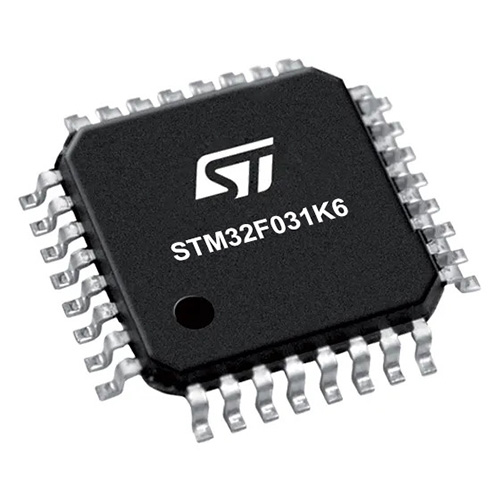
Architecture
ARM Cortex-M0
MCU Memory (KB)
32
Silicon Vendor
STMicroelectronics
Pin count
32
RAM (Bytes)
4096
You complete me!
Accessories
Click Shield for Nucleo-32 is the perfect way to expand your development board's functionalities with STM32 Nucleo-32 pinout. The Click Shield for Nucleo-32 provides two mikroBUS™ sockets to add any functionality from our ever-growing range of Click boards™. We are fully stocked with everything, from sensors and WiFi transceivers to motor control and audio amplifiers. The Click Shield for Nucleo-32 is compatible with the STM32 Nucleo-32 board, providing an affordable and flexible way for users to try out new ideas and quickly create prototypes with any STM32 microcontrollers, choosing from the various combinations of performance, power consumption, and features. The STM32 Nucleo-32 boards do not require any separate probe as they integrate the ST-LINK/V2-1 debugger/programmer and come with the STM32 comprehensive software HAL library and various packaged software examples. This development platform provides users with an effortless and common way to combine the STM32 Nucleo-32 footprint compatible board with their favorite Click boards™ in their upcoming projects.
Used MCU Pins
mikroBUS™ mapper
Take a closer look
Click board™ Schematic

Step by step
Project assembly
Software Support
Library Description
This library contains API for NFC Tag 4 Click driver.
Key functions:
nfctag4_password_present- This function presents password to device in order to open I2C security sessionnfctag4_enable_mailbox- This function enables or disables mailbox functionalitynfctag4_enable_rf- This function enables or disables RF functionality
Open Source
Code example
The complete application code and a ready-to-use project are available through the NECTO Studio Package Manager for direct installation in the NECTO Studio. The application code can also be found on the MIKROE GitHub account.
/*!
* \file
* \brief NfcTag4 Click example
*
* # Description
* This example showcases how to configure and use the NFC Tag 4 Click. The Click is an NFC tag
* interface which uses the I2C serial interface and an RF link interface in order to communicate.
* The example requires the ST25 NFC Tap application which can be downloaded to your phone.
*
* The demo application is composed of two sections :
*
* ## Application Init
* This function initializes and configures the logger and Click modules.
*
* ## Application Task
* This function waits for the interrupt signal, after which it expects data transfers. Once
* some data has been detected it will open a communication channel with the device transmitting
* it and show the received data in the UART console.
*
* \author MikroE Team
*
*/
// ------------------------------------------------------------------- INCLUDES
#include "board.h"
#include "log.h"
#include "nfctag4.h"
// ------------------------------------------------------------------ VARIABLES
static nfctag4_t nfctag4;
static log_t logger;
static uint8_t aux_buffer[ 258 ];
static uint16_t i;
static uint16_t message_length = 0;
static transfer_info info;
// ------------------------------------------------------- ADDITIONAL FUNCTIONS
void nfctag4_wait_for_int ()
{
uint16_t timer_counter = 0;
uint8_t int_pin_flag = 0;
int_pin_flag = nfctag4_int_get( &nfctag4 );
while ( ( int_pin_flag == 1 ) && ( timer_counter <= 300 ) )
{
Delay_ms ( 1 );
timer_counter++;
int_pin_flag = nfctag4_int_get( &nfctag4 );
}
if ( timer_counter <= 300 )
{
int_pin_flag = nfctag4_int_get( &nfctag4 );
while ( int_pin_flag == 0 )
{
int_pin_flag = nfctag4_int_get( &nfctag4 );
}
}
timer_counter = 0;
}
// ------------------------------------------------------ APPLICATION FUNCTIONS
void application_init ( void )
{
log_cfg_t log_cfg;
nfctag4_cfg_t cfg;
/**
* Logger initialization.
* Default baud rate: 115200
* Default log level: LOG_LEVEL_DEBUG
* @note If USB_UART_RX and USB_UART_TX
* are defined as HAL_PIN_NC, you will
* need to define them manually for log to work.
* See @b LOG_MAP_USB_UART macro definition for detailed explanation.
*/
LOG_MAP_USB_UART( log_cfg );
log_init( &logger, &log_cfg );
log_info( &logger, "---- Application Init ----" );
nfctag4_cfg_setup( &cfg );
NFCTAG4_MAP_MIKROBUS( cfg, MIKROBUS_1 );
nfctag4_init( &nfctag4, &cfg );
nfctag4_default_cfg( &nfctag4 );
}
void application_task ( void )
{
nfctag4_wait_for_int( );
info.memory_area = NFCTAG4_MEMORY_DYNAMIC;
info.register_address = NFCTAG4_DYNAMIC_REG_MB_CTRL;
info.n_registers = 1;
nfctag4_i2c_get( &nfctag4, &info, aux_buffer );
if ( ( aux_buffer[ 0 ] & 0x04 ) == ( 0x04 ) )
{
nfctag4_wait_for_int( );
info.memory_area = NFCTAG4_MEMORY_DYNAMIC;
info.register_address = NFCTAG4_DYNAMIC_REG_MB_LEN;
info.n_registers = 1;
nfctag4_i2c_get( &nfctag4, &info, aux_buffer );
message_length = aux_buffer[ 0 ];
message_length++;
nfctag4_wait_for_int( );
info.memory_area = NFCTAG4_MEMORY_MAILBOX;
info.register_address = NFCTAG4_MAILBOX_REG_BYTE_0;
info.n_registers = message_length;
nfctag4_i2c_get( &nfctag4, &info, aux_buffer );
log_printf( &logger, "************* MESSAGE ***************\r\n" );
log_printf( &logger, " ** Message length: %u Bytes**\r\n", message_length );
for ( i = 0; i < message_length; i++ )
{
log_printf( &logger, " %u : 0x%x\r\n", i, ( uint16_t ) aux_buffer[ i ] );
}
log_printf( &logger, "************** END ****************\r\n" );
}
}
int main ( void )
{
/* Do not remove this line or clock might not be set correctly. */
#ifdef PREINIT_SUPPORTED
preinit();
#endif
application_init( );
for ( ; ; )
{
application_task( );
}
return 0;
}
// ------------------------------------------------------------------------ END
Additional Support
Resources
Category:RFID/NFC



